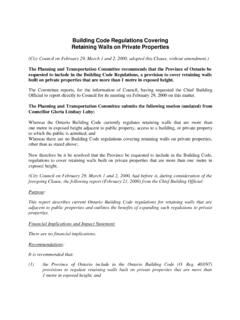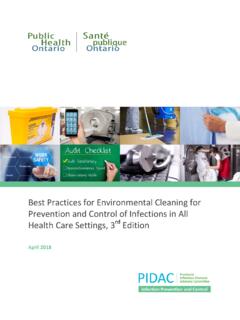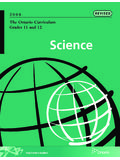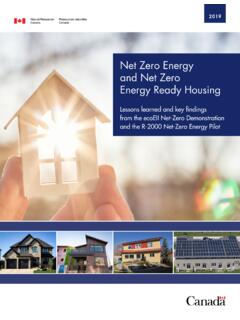Transcription of Pavement Design and Rehabilitation Guideline - Toronto
1 Pavement Design and Rehabilitation Guideline Second Edition, 2019 (Blank Page) This page is intentionally left blank. Pavement Design and Rehabilitation Guideline ii Pavement Design and Rehabilitation Guideline Second Edition, 2019 Published by City of Toronto Infrastructure Asset Management & Programming Transportation Services Division City Hall 100 Queen Street West East Tower, 22nd Floor Toronto , ontario M5H 2N2 April 2019 (Blank Page) This page is intentionally left blank. Pavement Design and Rehabilitation Guideline iii Enquiries regarding the purchase and distribution of this Pavement Design and Rehabilitation Guideline should be directed to: City of Toronto Infrastructure Asset Management & Programming Transportation Services Division City Hall 100 Queen Street West East Tower, 22nd Floor Toronto , ontario M5H 2N2 (Blank Page) This page is intentionally left blank.
2 Pavement Design and Rehabilitation Guideline iv Executive Summary For over a century, the City of Toronto 's Pavement infrastructure has been routinely constructed, maintained, and enhanced. Roads have been constructed using a variety of Pavement structural designs depending on the location within the city, function, the soil, and traffic conditions. Over the past several decades, research and other technological advancements in the Pavement engineering field have brought a gradual shift in Design and construction thinking. This shift has been observed in terms of how pavements and Pavement materials are designed, tested, evaluated, constructed and managed. Pavement Design is steadily changing from an art to a science. In 2006, the City published Pavement Structural Design Guideline [1] mostly focusing on the Design of new Pavement construction.
3 As the City and associated infrastructure ages, the need for cost effective maintenance, repairs, Rehabilitation and replacement continues to grow. Due to the gaps in the 2006 Pavement Structural Design Guideline , in April 2017, Transportation Infrastructure Management Section, Infrastructure Asset Management & Programming Unit formed a task group consisting of members from the Engineering and Construction Services and Transportation Services Division. These members collaborated for more than a year to finalize the contents within this document. Committees were formed to solicit wider feedback as the Pavement Design and Rehabilitation Guideline is applicable to other stakeholders such as Road Operations and Public Realm Section. Beginning of 2019, as part of Transportation Services divisional business transformation, the City is moving towards implementation of AASHTO 1993 Pavement Design guidelines [2] along with the MTO MI-183 report entitled "Adaptation and Verification of AASHTO Pavement Design Guide for ontario Conditions" [3] for the verification of all road Rehabilitation works as per best industry practices.
4 New revisions in this Pavement Design and Rehabilitation Guideline include Superpave Mix Design , Life Cycle Cost analysis, Enhanced/New Material tests and Non-Destructive testing (NDT), for example Ground Penetrating Radar (GPR), Falling Weight Deflectometer (FWD), and Friction Resistance testing . The Guideline also includes network level planning to project level Design context, clarification around Laneways & Expressway Design , clarity around Road Operations/Maintenance and improved Pavement treatment Service Lives clarity. Finally, revisions also comprise of Pavement reconstruction age triggers, clarity around other assets Design and linkage with Pavement Design , consistent coring/boring frequency guidance, Pavement Design and Rehabilitation Guideline v improved focus on Pavement Design using the AASHTO 1993 guidelines , and a new chapter on constructability and improved drainage Design .
5 This Pavement Design and Rehabilitation Guideline (PDRG) shall act as a guidance document to be followed by engineering consultants and City staff when engaged in Design functions for City Pavement and related transportation assets. Future enhancements of this guide may include Pavement structural Design updates to reflect the 2015 American Association of State Highway and Transportation Officials (AASHTO) Mechanistic Empirical Pavement Design (MEPD) Guide, calibrated for City, ontario Ministry of Transportation, and Greater Toronto Area experience along with ongoing revisions reflecting best practices in materials specifications and emerging policies and regulations. (Blank Page) This page is intentionally left blank. Pavement Design and Rehabilitation Guideline v What's New?
6 In 2006, the Pavement Structural Design Guideline was released. As part of continued business improvements and enhancements, the new 2019 Pavement Design and Rehabilitation Guideline (PDRG) provides enhancements and additions in terms of: 1. Non-Destructive testing (NDT), for example Ground Penetrating Radar (GPR), Falling Weight Deflectometer (FWD) and Frictional Resistance testing , etc. 2. Enhanced/new material tests 3. Consistent and modified guidance for Coring/Boring frequency with and without NDT 4. Improved focus on Pavement Design using AASHTO 1993 guidelines 5. Network level planning to Project Level Design context clarity 6. Pavement age reconstruction triggers 7. Clarification around Laneways & Expressways Design 8. Improved guidance on Pavement treatment service lives 9. Superpave Mix Design 10. Improved drainage Design focus 11.
7 Life Cycle Cost analysis to identify the best value-for-money Rehabilitation alternative 12. New chapter on constructability 13. Clarity around Road Operations/Maintenance 14. Discussion of other related Assets and linkage with Pavement Design 15. Best practices in Pavement materials, selection and specification to reflect the City's Climate Change Risk Management Policy and related Climate Change Risk Assessments (Blank Page) This page is intentionally left blank. Pavement Design and Rehabilitation Guideline vi Technical Working Committees Focused technical working committees were formed to engage the Engineering & Construction Services (ECS) and Transportation Services (TS) Divisions to gain their input from a Design , constructability and delivery perspective. A list of the technical working committee members is presented below: Chair: Mark Berkovitz, Infrastructure Asset Management & Programming, TS Co-Chair and Lead: Riaz Ahmed, Infrastructure Asset Management & Programming, TS Coordinator (s): Prabir Das, Infrastructure Asset Management & Programming, TS Jawaid Choudhary, Infrastructure Asset Management & Programming, TS Rahanuma Wafa, Infrastructure Asset Management & Programming, TS Engineering and Construction Services Division Members 1.
8 Bill Dakogiannis, Local Roads, ECS 2. Chris Myers, Office of the Executive Director, ECS 3. Jerry Higgins, Soil & Groundwater Quality, ECS 4. Michael Popik, Major Roads, ECS 5. Robert Klimas, Business Improvement and Standards, ECS 6. Rogerd Morales, Basement Flooding Protection Program, ECS 7. Steven Bertolo, Local Roads, ECS Transportation Services Division Members 1. Demetrios Christodoulou, Surface Maintenance & Utility Cut Operations, TS 2. Frederik Meco, Road Operations, TS 3. Gregory Ruffa , Road Operations, TS 4. Zachary Brown, Surface Maintenance, TS 5. Daniel Lopes, Road Operations, TS 6. Jaime Thomas, Road Operations, TS 7. Phil Pendleton, Infrastructure Asset Management & Programming, TS 8. Mohamed Siddiqui, Infrastructure Asset Management & Programming, TS 9. Owen McGaughey, Cycling Infrastructure & Programs, TS 10.
9 Kanchan Maharaj, Cycling Infrastructure & Programs, TS 11. Justin Bak, Cycling Infrastructure & Programs, TS 12. Daphne Wee, Pedestrian Infrastructure & Programs, TS 13. Jason Neil, Pedestrian Infrastructure & Programs, TS 14. Shawn Dillon, Cycling Infrastructure & Programs, TS Transportation Services Division Engineering/Technical Trainees 1. Yuvna Apajee, Infrastructure Asset Management & Programming , TS 2. Danrong Wang, Infrastructure Asset Management & Programming , TS External Technical Review Input: 1. Tom Kazmierowski, Golder Associates Ltd. 2. Michael Maher, Golder Associates Ltd (Blank Page) This page is intentionally left blank. Pavement Design and Rehabilitation Guideline vii Acknowledgments This Pavement Design and Rehabilitation Guideline demonstrates the talents and dedication of the City staff from various Divisions and Units.
10 We would like to thank the staff of the Transportation Infrastructure Management Section, Engineering & Construction Services, Road Operations and Public Realm Section for their involvement in making this Guideline a reality. The City of Toronto would like to thank Tom Kazmierowski and Michael Maher of Golder Associates Ltd. for their review in developing this Guideline . All participants were committed to creating a practical resource that will provide a practical guidance document to be followed by external engineering consultants and City staff when engaged in Pavement Design and Rehabilitation projects so as to support the delivery of cost effective and safe road infrastructure in the City. The advice, input and participation received throughout the consultation process is gratefully appreciated.













